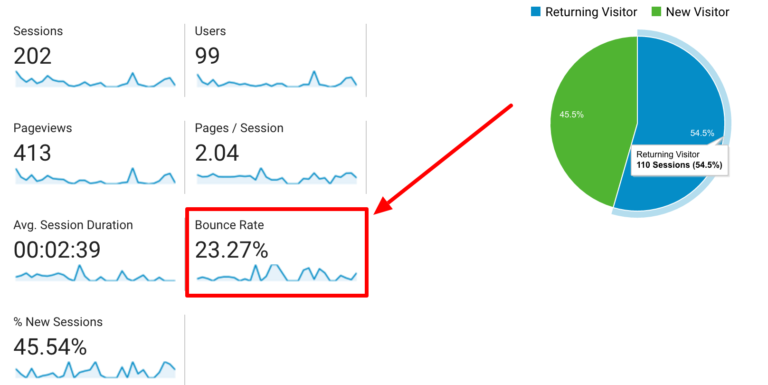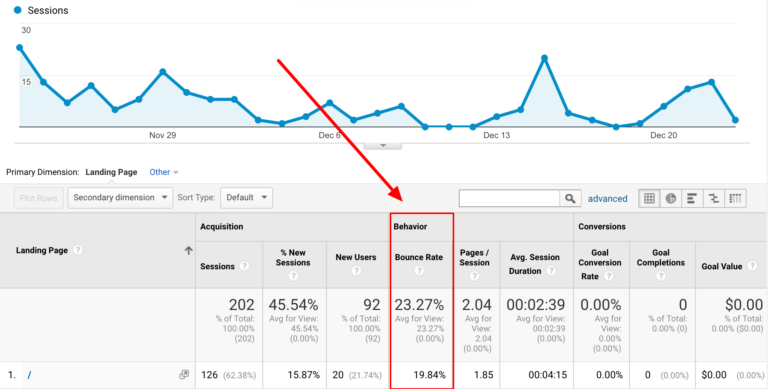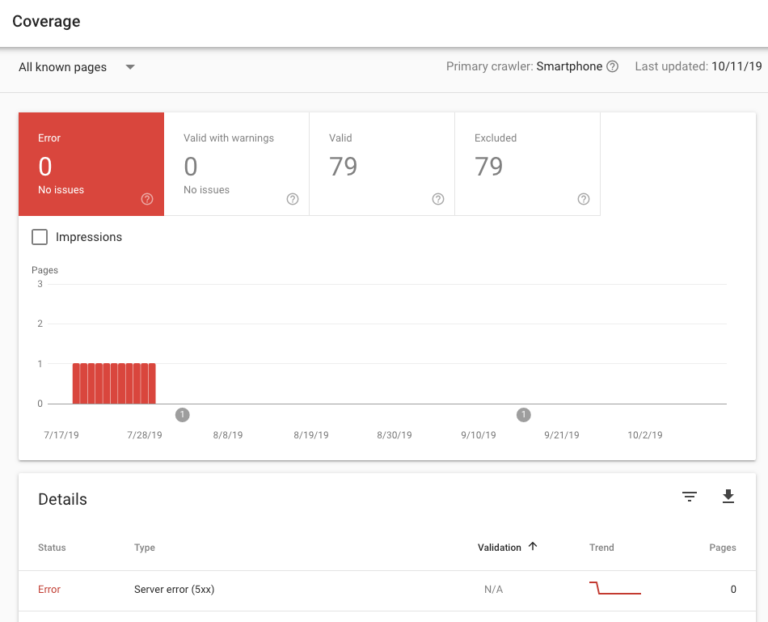31 Oct 11 Reasons Your Website Can Have a High Bounce Rate via @amelioratethis
The dreaded high bounce rate.
It makes the shoulders of online marketers tense up and causes their foreheads to wrinkle up with concern.
What Is Bounce Rate?
As a refresher, bounce rate refers to the percentage of visitors that leave your website (or “bounce” back to the search results or referring website) after viewing only one page on your site.
Before you start worrying, consider that “high” is a relative term.
Most websites will see bounce rates between 26% to 70%, according to a RocketFuel study.


Based on the data they gathered, they provided a bounce rate grading system of sorts:
- 25% or lower: Something is probably broken
- 26-40%: Excellent
- 41-55%: Average
- 56-70%: Higher than normal, but could make sense depending on the website
- 70% or higher: Bad and/or something is probably broken
The overall bounce rate for your site will live in the Audience Overview tab of Google Analytics.


You can find your bounce rate for individual channels and pages in the behavior column of most views in Google Analytics.


There are a number of reasons your website can have a high bounce rate.
Let’s review 10 common ones and how to fix them.
1. Slow-to-Load Page
Site speed is part of Google’s ranking algorithm, so it’s just good SEO to focus on it.
Google wants to promote content that provides a positive experience for users, and they recognize that a slow site can provide a poor experience.
If your page takes longer than a few seconds to load, your visitors may get fed up and leave.
Fixing site speed is a lifelong journey for most SEO pros and webmasters, but the upside is that with each incremental fix, you should see an incremental boost in speed.
Review your page speed (overall and for individual pages) using tools like:
- Google PageSpeed Insights.
- Pingdom.
- GTMetrix.
They’ll offer you recommendations specific to your site, such as compressing your images, reducing third-party scripts, and leveraging browser caching.
2. Self-Sufficient Content
In some cases, the user will get everything they were looking for from the page on your site.
This can be a wonderful thing – perhaps you’ve achieved the content marketer’s dream and created awesome content that wholly consumed them for a handful of minutes in their lives!
Or perhaps you have a landing page that only requires the user to complete a short lead form.
To determine whether bounce rate is nothing to worry about, you’ll want to look at the Time Spent on Page and Average Session Duration metrics in Google Analytics.
If the user is spending a couple of minutes or more on the page, that sends a positive signal to Google that they found your page highly relevant to their search query. If you want to rank for that particular search query, that kind of user intent is gold.
If the user is spending less than a minute on the page (which may be the case of a properly optimized landing page with a quick-hit CTA form), consider enticing the reader to read some of your related blog posts after filling out the form.
3. Disproportional Contribution by a Few Pages
If we expand on the example from the previous section, you may have a few pages on your site that are contributing disproportionally to the overall bounce rate for your site. Google is savvy at recognizing the difference between these.
So if your single CTA landing pages reasonably satisfy user intent and cause them to bounce quickly after taking action, but your longer-form content pages have a lower bounce rate, you’re probably good to go.
However, you will want to dig in and confirm that this is the case or discover if some of these pages with a higher bounce rate shouldn’t be causing users to leave en masse.
Open up Google Analytics, go to Behavior > Site Content > Landing Pages, and sort by Bounce Rate.
Consider adding an advanced filter to remove pages that might skew the results.
For example, it’s not necessarily helpful to agonize over the one Twitter share with 5 visits that have all your social UTM parameters tacked onto the end of the URL.
My rule of thumb is to determine a minimum threshold of volume that is significant for the page.
Choose what makes sense for your site, whether it’s 100 visits or 1,000 visits, then click on Advanced and filter for Sessions greater than that.


4. Misleading Title Tag and/or Meta Description
Ask yourself: Is the content of your page accurately summarized by your title tag and meta description?
If not, visitors may enter your site thinking your content is about one thing, only to find that it isn’t, and then bounce back to whence they came.
Whether it was an innocent mistake or you were trying to game the system by optimizing for keyword clickbait (shame on you!), this is, fortunately, simple enough to fix.
Either review the content of your page and adjust the title tag and meta description accordingly or rewrite the content to address the search queries you really want to attract visitors for.
5. Blank Page or Technical Error
If your bounce rate is exceptionally high and you see that people are spending less than a few seconds on the page, it’s likely your page is blank, returning a 404, or otherwise not loading properly.
Take a look at the page from your audience’s most popular browser and device configurations (e.g., Safari on desktop and mobile, Chrome on mobile, etc.) to replicate their experience.
You can also check in Search Console under Coverage to discover the issue from Google’s perspective. Correct the issue yourself or talk to someone who can – an issue like this can cause Google to drop your page from the search results in a hurry.


6. Bad Link from Another Website
It’s possible you could be doing everything perfect on your end to achieve a normal or low bounce rate from organic search results, and still have a high bounce rate from your referral traffic.
The referring site could be sending you unqualified visitors or the anchor text and context for the link could be misleading.
Sometimes this is a result of sloppy copywriting. The writer or publisher linked to your site in the wrong part of the copy, or didn’t mean to link to your site at all.
Start by reaching out to the author of the article, then the editor or webmaster if the author doesn’t have the ability to update post-publish.
Plead your case and politely ask them to remove the link to your site or update the context, whichever makes sense.
(Tip: you can easily find their contact information with this awesome guide by Joshua Daniels.)
Unfortunately, the referring website may be trying to sabotage you with some negative SEO tactics, out of spite or just for fun.
For example, they may have linked to your Guide to Adopting a Puppy with the anchor text of FREE GET RICH QUICK SCHEME.
You should still reach out and politely ask them to remove the link, but if needed, you’ll want to update your disavow file in Search Console.
Disavowing the link won’t reduce your bounce rate, but it will tell Google not to take that site’s link into account when it comes to determining the quality and relevance of your site.
7. Affiliate Landing Page or Single-Page Site
If you’re an affiliate, the whole point of your page may be to deliberately send people away from your website to the merchant’s site.
In these instances, you’re doing the job right if the page has a higher bounce rate.
A similar scenario would be if you have a single-page website, such as a landing page for your ebook or a simple portfolio site.
It’s common for sites like these to have a very high bounce rate since there’s nowhere else to go.
Remember that Google can usually tell when a website is doing a good job satisfying user intent even if the user’s query is answered super quickly (sites like WhatIsMyScreenResolution.com come to mind).
If you’re interested, you can adjust your bounce rate so it makes more sense for the goals of your website.
8. Low-Quality or Under Optimized Content
Visitors may be bouncing from your website because your content is just plain bad.
Take a long, hard look at your page and have your most judgmental and honest colleague or friend review it (ideally, this person either has a background in content marketing or copywriting, or they fall into your target audience).
One possibility is that your content is great, but you just haven’t optimized it for online reading.
- Are you writing in simple sentences (think high school students vs. PhDs)?
- Is it easily scannable with lots of header tags?
- Have you included images to break up the copy and make it easy on the eyes?
Writing for the web is different than writing for written publications.
Brush up your online copywriting skills to increase the time people spend reading your content.
The other possibility is that your content is poorly written overall or simply isn’t something your audience cares about.
Consider hiring a freelance copywriter or content strategist who can help you revamp your ideas into powerful content that converts.
9. Bad or Obnoxious UX
Are you bombarding people with ads, pop-up surveys, and email subscribe buttons?
CTA-heavy features like these may be irresistible to the marketing and sales team, but using too many of them can make a visitor run for the hills.
Is your site confusing to navigate?
Perhaps your visitors are looking to explore more, but your blog is missing a search box or the menu items are difficult to click on a smartphone.
As online marketers, we know our websites in and out. It’s easy to forget that what seems intuitive to us is anything but to our audience.
Make sure you’re avoiding these common design mistakes, and have a web or UX designer review the site and let you know if anything pops out to them as problematic.
10. The Page Isn’t Mobile-Friendly
While we know it’s important to have a mobile-friendly website, the practice isn’t always followed in the real world.
In fact, one study found that nearly a quarter of the top websites in 2018 were indeed not mobile-friendly.
Websites that haven’t been optimized for mobile don’t look good on mobile devices – and they don’t load too fast, either. That’s a recipe for a high bounce rate.
Even if your website site was implemented using responsive design principles, it’s still possible that the live page doesn’t read as mobile-friendly to the user.
Sometimes, when a page gets squeezed into a mobile format, it causes some of the key information to move below-the-fold.
Now, instead of seeing a headline that matches what they saw in search, mobile users only see your site’s navigation menu.
Assuming the page doesn’t offer what they need, they bounce back to Google.
If you see a page with a high bounce rate and no glaring issues immediately jump out to you, test it on your mobile phone.
You can identify non-mobile-friendly pages at-scale using Google’s free Test My Site tool.


11. Wonky Google Analytics Setup
It’s possible that you haven’t properly implemented Google Analytics and added the tracking codes to all the pages on your site.
Google explains how to fix that here.
5 Pro Tips for Reducing Your Bounce Rate
Regardless of the reason behind your high bounce rate, here’s a summary of best practices you can implement to bring it down.
1. Make Sure Your Content Lives Up to the Hype
Your title tag and meta description effectively act as your website’s virtual billboard in Google.
Whatever you’re advertising in the SERPs, your content needs to match.
Don’t call your page an ultimate guide if it’s a short post with three tips.
Don’t claim to be the “best” vacuum if your user reviews show a 3-star rating.
You get the idea.
Also, make your content readable:
- Break up your text with lots of white space.
- Add supporting images.
- Use short sentences.
- Spellcheck is your friend.
2. Keep Critical Elements Above the Fold
Sometimes, your content matches what you advertise in your title tag and meta description; visitors just can’t tell at first glance.
When people arrive on a website, they make an immediate first impression.
You want that first impression to validate whatever they thought they were going to see when they arrived.
A prominent H1 should match the title they read on Google.
If it’s an ecommerce site, a photo should match the description.
3. Speed Up Your Site
When it comes to SEO, faster is always better.
Keeping up with site speed is a task that should remain firmly stuck to the top of your SEO to-do list.
There will always be new ways to compress, optimize, and otherwise accelerate load time.
- Implement AMP.
- Compress all images before loading them to your site, and only use the maximum display size necessary.
- Review and remove any external or load-heavy scripts, stylesheets, and plugins. If there are any you don’t need, remove them. For the ones you do need, see if there’s a faster option.
- Tackle the basics: Use a CDN, minify JavaScript and CSS, and set up browser caching.
4. Minimize Non-Essential Elements
Don’t bombard your visitors with pop-up ads, in-line promotions, and other content they don’t care about.
Visual overwhelm can cause visitors to bounce.
What CTA is the most important for the page?
Highlight that in a compelling way.
For everything else, delegate it to your sidebar or footer.
5. Help People Get Where They Want to Be Faster
Want to encourage people to browse more of your site?
Make it easy for them.
Leverage on-site search with predictive search, helpful filters, and an optimized “no results found” page.
Rework your navigation menu and A/B test how complex vs. simple drop-down menus affect your bounce rate.
Include a Table of Contents in your long-form articles with anchor links taking people straight to the section they want to read.
Summary
Hopefully, this article will help you diagnose what’s causing your high bounce rate, and you have a good idea how to fix it.
Now get to it!
More Resources:
- Understanding Bounce Rate & How to Audit It
- How to Reduce Your Bounce Rate: 20 Tips That Work
- How to Use User Behavior Analytics to Increase Your Conversions: 5 Tips
Image Credits
In-Post Image: RocketFuel
All screenshots taken by author, October 2019
Sorry, the comment form is closed at this time.